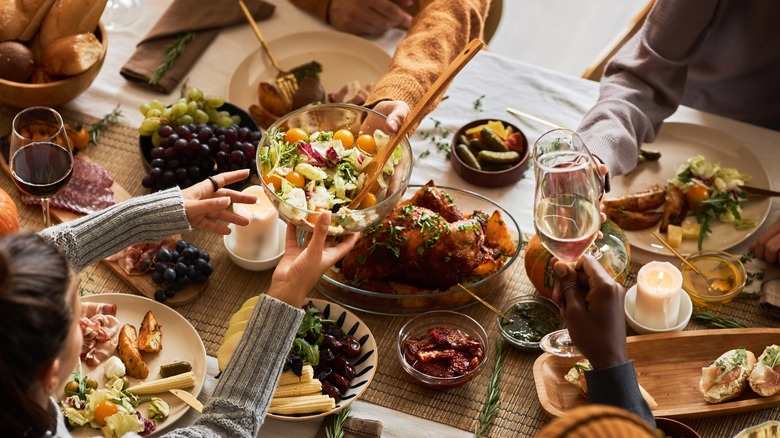Hosting 101: The Common Menu Mistake To Avoid At All Costs
Nothing makes you feel more like a grown-up than having a dinner party in your own space. Having a place to host your friends and loved ones is a true luxury that many of us dream about. But when that dream turns into reality, it can quickly sour into a nightmare if you aren't careful. You may have the venue all figured out, but volunteering to host also means deciding who will attend, when everyone can get together, and what you can cook that everyone will enjoy.
Don't overcomplicate your menu to avoid unnecessary stress in the kitchen while hosting. Event planner Virginia Frischkorn told Martha Stewart that the key to a stress-free party menu is to keep it simple. Today is not the day to try out that new recipe you saw on TikTok or attempt to recreate a dish you vaguely remember your family making way back in the day. Assemble a few trusty dishes that you are confident in preparing, and that match the dinner party's vibe.
Too much of a good thing can ruin your dinner party
Being a better host means not only serving tasty bites but ensuring there is a balance of simple, enjoyable food options. Remember that a simple menu does not mean less – you always want to make sure you have enough food for all your guests. On the opposite end of the spectrum, however, your friends and family do not need a massive feast at every function. Overloading the menu with too many items can overwhelm you as a host, as well as your guests, and offering too many options can lead to low-quality dishes. When planning your event, be clear about what you'll be serving. A mid-afternoon gathering may only call for a few finger foods and some refreshing drinks, while an evening sit-down dinner invite implies a much larger spread.
Don't be afraid to outsource certain dishes, either. Your bestie can be in charge of bringing her famous raspberry cheesecake, and no one will think less of you if the breadsticks are store-bought. (If any of them do judge you, you may want to rethink your guest list rather than the menu). What is even more important than good eats is that the host can mingle with their guests — no one enjoys a party where they are stuck in the kitchen all night, no matter how tasty the food is.
When curating a menu, consider what your guests will actually enjoy eating
Contrary to popular belief, you don't need to cook anything fancy to host a successful party. Sometimes the simpler the menu, the better it is. Bumps of caviar and steak tartare are great for indulgent foodies, but they may not be a hit at your kid's birthday party. While a menu full of dishes that are tough to pronounce may make you look well-traveled, it won't do much good if a majority of your guests don't enjoy the taste. Keep the food simple, and comforting, to allow guests a better chance of actually liking what you are offering. No one will turn their noses up at a pizza night or a fondue party.
Keep in mind when you are serving any type of food to a crowd that many people have complex needs or restrictions. An RSVP to a dinner party may be difficult for those who are on a plant-based or vegan diet, or those who are navigating dietary changes due to health and lifestyle choices. Of course, you cannot be expected to cater to every single person's dietary restrictions, but you can craft a spread that allows guests to pick and choose which foods to enjoy. This is when a nice charcuterie board or even a potluck-style party will be especially beneficial.


